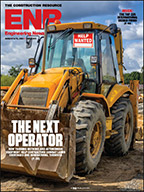
Austerity in public markets in the U.S. and Europe as well as mining-sector falloffs in the Southern Hemisphere are dampening international design firms’ revenue and profits, but CEOs are looking to new markets and altered strategies to stay on a growth track, said 270 global engineering and design-build chiefs who convened in New York City in October at an annual management conference.
For Arcadis, the Dutch-based global giant, working globally has been "great, OK and still ugly," company CEO Neil McArthur told peers at the event on Oct. 16-17, sponsored by industry financial and management services firm EFCG.
He said work in emerging economies now comprises 25% of the firm's portfolio. The U.S. initially posed uncertainty to the firm, he added, but "turned out OK," and Europe "remains ugly" with negative growth and lower margins.
“Western governments are all broke. It’s pretty tough and will stay that way,” Jacobs Engineering Group Chairman Noel Watson said. “It’s the new norm for this decade, and we need to plan for what we see today.”
EFCG President Paul Zofnass noted that growth fell for 40 respondents, compared to 33 firms last year, according to its survey of 220 companies. But ever optimistic, respondents predict a median growth rate of 7% in 2014, with median margins of 11.8%, he said.
“We are so focused on profit because the model breaks down if returns are not there with the risks you take,” said Paul Hardy, CEO of Australian firm Aurecon.
On the day the U.S. government shutdown ended, CEOs of several industry giants said there would still be business and project impacts from a changing federal marketplace. They were hopeful that work from municipal and private clients could fill some of the gap, noting the potential for more design-build and public-private ventures. HNTB group chief Ed McSpedon said engineers can expedite payment through design-build.
But Parsons Brinckerhoff’s George Pierson and other CEOs voiced concerns about uncertainties related to health coverage under the Affordable Care Act and higher costs for employees and firms. EFCG said 51% of firms expected a minimal impact, but 26% said it would be “noticeable,” with costs up as much as 25%.
Stantec CEO Bob Gomes said firms’ approaches to implementing the new rules and managing costs “will be a differentiator” in attracting new employees.
That was key for CEOs, with turnover averaging 15.5% among the largest surveyed firms, those with revenue above $1 billion. Pierson noted the challenge of keeping large firms “personal and less numbers-oriented.”
Of $38 billion reported by EGCG survey respondents in non-U.S. revenue, 28% was in Canada, the largest share, with 16% in Australia, 15% in Europe and 12% in the U.K. The 40% share of non-U.S. revenue that firms reported in 2013 compares to 7% in 1995, the survey said.
Europe is Slow Moving
The large contingent of European firm executives were dismayed but resigned to continued doldrums in that depressed region but some are making the best of it.
"We've grown 10% every year," said Jens-Peter Saul, CEO of Denmark-based Ramboll, noting that Nordic countries are spending "what they can afford."
Jim Stamatis, president of U.S.-based Berger Group's international arm, said the firm "was looking at maintaining a presence in Europe but not looking at strong growth," particularly in the public sector. He noted that "investment is limited unless money is coming in from other sectors such as banking."
Canadian designer Golder Associates' private-sector focus has made its European business "the best in 20 years," said CEO Brian Conlin, noting owners' increased business discipline and having "the right people focused on the right clients."
He and others still see potential in eastern Europe and Central Asia. "Kazakstan, Turkey and Poland are actually good opportunities on the private side," said Conlin. "I'm quite excited."
Peter Van Kerckhove, chairman of Belgium's VK Group, said that although the European Union aims to boost GDPs and infrastructure standards of its newly-admitted eastern European members, "the difficulty there is political rivalry." He said that such disputes are thwarting Romania's efforts to expand its current 450-kilometer highway network. "Politicians can't decide where new ones should be routed, it's a problem," he said. "Once these countries get more maturity, there will be big potential there."
Ups and Downs in Asia
Although some engineering firms have made inroads in the Chinese and Indian markets, profitability remains elusive because of strong cultural obstacles, CEOs said. The were no Chinese or Indian firms on the EFCG panel or even at the conference.
WorleyParsons has prospered by serving Chinese clients working outside of the People's Republic or serving multinational chemical firms, said Managing Director Iain Ross. The firm has 2,700 staffers in China "and we make money there," he said.
McArthur noted that China's GDP, just 25% of Germany's in the 1990s, has since grown 40 times as fast. He said that the number of Chinese companies in the Fortune 500 has grown to 70 from just 10 in a decade.
Simon Naylor, Americas president for AMEC Environment & Infrastructure, said the firm's "proposition offered" to the Chinese also involved overseas support to firms working in Australia, South America and Canada. It has 600 employees based in China.
The country's "Catch-22 licensing program" for overseas engineers is a problem, said SNC-Lavalin CEO Robert Card. "You have to be there already doing the work to get a license to do the work," he said. "The Chinese have lots of engineers and would rather do it themselves."
Gregs Thomopulos, chairman of U.S.-based Stanley Consultants and a former president of the International Federation of Design Firms (FIDIC), said "the Chinese have [their] own agenda," with only language and knowledge of FIDIC's international contracting documents "holding them back". He said FIDIC now is working with Chinese design officials "to prepare Chinese engineers to work abroad."
Added the CEO of an Australian engineering firm, "there are opportunities now, but it is a matter of time before they no longer need us," he said. Competing "will be tough for us as smaller-size firm, [and] China will no longer be the place for us."
Paul Hardy, CEO of Australian engineer Aurecon, told peers that Chinese firms are making strong inroads in Africa "and they bring everything—the money, the technology, the equipment, even the cement and plaster to build apartments in Angola."
But he emphasized that Chinese work quality abroad is mixed, noting that "we have a successful business in Angola rebuilding Chinese roads that only last a couple of years, so we’re enjoying that." He also pointed to corruption issues and growing tension with local vendors related to Chinese competition.







Post a comment to this article
Report Abusive Comment